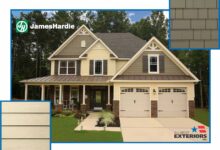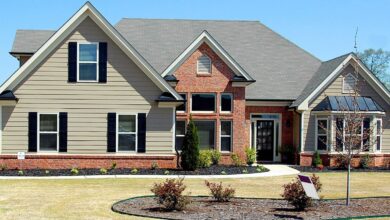Siding Contractor Near Me: Find the Best
Siding contractor near me—finding the right one can transform your home’s exterior. This guide explores the competitive landscape of local siding contractors, detailing how to select a qualified professional and navigate the entire process, from initial consultation to post-installation care. We’ll cover crucial factors like pricing strategies, material options (vinyl, fiber cement, wood), and project scope, ensuring you’re well-equipped to make informed decisions for your home improvement project.
Understanding homeowner priorities, such as budget constraints and aesthetic preferences, is key. We’ll delve into the importance of verifying contractor credentials, including licenses and insurance, and highlight the potential pitfalls of hiring unqualified professionals. Ultimately, this comprehensive guide aims to empower you to find the perfect siding contractor and achieve your dream home exterior.
Local Market Research
Understanding the competitive landscape of siding contractors is crucial for success. A typical geographic area will exhibit varying levels of competition, influenced by factors such as population density, housing age, and recent weather events (e.g., hailstorms impacting a significant portion of homes). This research helps identify opportunities and inform strategic decisions.
Competitive Landscape of Siding Contractors
The competitive landscape for siding contractors often includes a mix of large national chains, regional companies, and smaller, independent businesses. National chains typically offer standardized services and pricing, while regional and independent contractors may provide more personalized service and potentially more competitive pricing depending on their overhead costs and market position. Competition also stems from the availability of DIY options and the rise of online marketplaces connecting homeowners with contractors. The level of competition can be high, especially in areas with a large number of homeowners and a significant demand for home improvement services.
Key Differentiators for Successful Siding Contractors
Three key differentiators often employed by successful siding contractors include superior customer service, specialized expertise, and a strong online presence. Superior customer service involves responsive communication, transparent pricing, and a commitment to exceeding client expectations. Specialized expertise may involve proficiency in installing specific types of siding (e.g., fiber cement, vinyl, metal) or possessing certifications related to energy efficiency or other niche areas. A strong online presence involves a professional website with high-quality images, positive client reviews, and effective search engine optimization (SEO) to attract local customers.
Pricing Strategies of Siding Contractors
Siding contractors employ various pricing strategies, including fixed-price contracts, hourly rates, and cost-plus pricing. Fixed-price contracts offer certainty for both the contractor and the homeowner, but require accurate initial assessments. Hourly rates offer flexibility but can be unpredictable in terms of final cost. Cost-plus pricing, where the homeowner pays for materials and the contractor charges an hourly rate for labor, is less common but can be beneficial in complex projects. Competition often drives contractors to offer competitive pricing, discounts, or financing options to attract customers. Some contractors might focus on premium pricing to emphasize quality and service, while others opt for lower prices to capture a larger market share.
Key Features and Services of Top-Rated Siding Contractors
| Feature/Service | Contractor A | Contractor B | Contractor C |
|---|---|---|---|
| Types of Siding Installed | Vinyl, Fiber Cement, Wood | Vinyl, Aluminum, Steel | Fiber Cement, Engineered Wood, Vinyl |
| Warranty Offered | Lifetime on materials, 1 year labor | 25 years on materials, 2 years labor | Lifetime on materials, 5 years labor |
| Free Estimates/Consultations | Yes | Yes | Yes |
| Financing Options | Available | Not Available | Available |
| Insurance/Licensing | Fully Insured and Licensed | Fully Insured and Licensed | Fully Insured and Licensed |
| Customer Reviews | 4.8 stars (150+ reviews) | 4.5 stars (75+ reviews) | 4.7 stars (200+ reviews) |
Customer Needs and Preferences
Homeowners considering siding replacement or installation prioritize a combination of aesthetic appeal, durability, energy efficiency, and budget considerations. Understanding these needs is crucial for siding contractors to effectively market their services and build strong customer relationships. This section details the typical concerns and preferences of homeowners, exploring how various siding materials meet these diverse demands.
Homeowners seeking new siding typically have a range of concerns. These include the overall curb appeal and how the new siding will enhance their home’s appearance. Durability and longevity are also key, with homeowners wanting a siding solution that will withstand the elements and require minimal maintenance for years to come. Energy efficiency is another major factor, as homeowners are increasingly interested in reducing energy costs and improving their home’s environmental impact. Finally, budget constraints play a significant role, influencing the choice of siding material and the overall project scope.
Siding Material Choices and Their Suitability
Different siding materials cater to various homeowner needs and budgets. Vinyl siding offers a cost-effective solution, providing a wide range of colors and styles with relatively low maintenance requirements. However, it may not offer the same durability or aesthetic appeal as higher-end options. Fiber cement siding, while more expensive than vinyl, boasts superior durability, fire resistance, and a more natural look. Wood siding, though aesthetically pleasing and offering a classic appeal, requires more significant maintenance and is prone to rot and insect damage if not properly cared for. The choice often depends on a balance between desired features, longevity expectations, and financial limitations. For example, a homeowner on a tight budget might opt for vinyl, while one prioritizing longevity and a premium look might choose fiber cement. A homeowner who values the classic aesthetic might choose wood, understanding the increased maintenance commitment.
Targeted Marketing Messages
Effective marketing strategies should tailor messages to resonate with specific homeowner demographics. For instance, a campaign targeting younger, budget-conscious homeowners could emphasize the affordability and low-maintenance aspects of vinyl siding, highlighting its versatility in creating modern and stylish homes. Conversely, a campaign focused on older, more affluent homeowners might emphasize the durability, longevity, and low-maintenance features of fiber cement siding, showcasing its ability to enhance the value and curb appeal of their established homes. Marketing materials should include high-quality images showcasing the diverse applications and styles of each siding material, allowing homeowners to visualize the potential transformation of their homes.
Common Homeowner Questions
Before hiring a siding contractor, homeowners frequently ask several key questions. Understanding these common inquiries allows contractors to proactively address potential concerns and build trust.
- What types of siding do you install, and what are the pros and cons of each?
- What is your experience with similar projects, and can you provide references?
- What is your estimated timeline for completion, and what is your process for managing the project?
- What is your pricing structure, and what is included in the total cost?
- What is your warranty policy, and what is your process for handling complaints or issues?
- What permits and licenses do you have, and are you insured?
- What is your approach to waste disposal and environmental considerations?
Contractor Selection Process
Choosing the right siding contractor is crucial for a successful project. A poorly chosen contractor can lead to subpar workmanship, cost overruns, and significant headaches. This section outlines the steps involved in selecting a reputable and qualified professional for your siding needs.
The process of selecting a siding contractor involves careful consideration of several key factors to ensure a positive outcome. This includes assessing their qualifications, experience, and reputation, as well as understanding the contractual agreements and payment schedules. Thorough research and due diligence are essential to protect your investment and avoid potential problems.
Verifying Licenses, Insurance, and Customer Reviews
Verifying a contractor’s licensing, insurance, and gathering customer reviews are vital steps in mitigating risk. A valid license demonstrates that the contractor has met the minimum requirements set by your local authorities, indicating a commitment to professional standards and compliance with building codes. Adequate insurance, including general liability and workers’ compensation, protects you from potential financial losses in case of accidents or damages during the project. Positive customer reviews provide valuable insights into the contractor’s reliability, quality of work, and customer service. Checking online platforms such as Yelp, Google Reviews, and the Better Business Bureau can reveal patterns of customer satisfaction or dissatisfaction.
Homeowner’s Checklist for Evaluating Siding Contractors
Before engaging a contractor, homeowners should use a comprehensive checklist to evaluate potential candidates. This checklist should include:
A thorough checklist helps homeowners make informed decisions and avoid potential pitfalls. This organized approach ensures all crucial aspects are considered before committing to a contractor.
- Licensing and Insurance Verification: Confirm valid state contractor’s license and proof of general liability and workers’ compensation insurance.
- Experience and References: Request a portfolio of past projects and contact references for feedback on the contractor’s work quality and professionalism.
- Detailed Estimates: Obtain detailed written estimates from multiple contractors, comparing pricing, materials, and timelines. Ensure the estimate clearly outlines all aspects of the project, including labor, materials, and any additional fees.
- Contractual Agreements: Carefully review the contract before signing, ensuring it includes a clear scope of work, payment schedule, warranty information, and dispute resolution mechanisms.
- Communication and Responsiveness: Assess the contractor’s communication skills and responsiveness to inquiries. A responsive and communicative contractor will ensure a smoother project process.
Risks of Hiring Unqualified or Unlicensed Contractors
Hiring unqualified or unlicensed contractors poses several significant risks. These risks include:
Engaging unlicensed or unqualified contractors can lead to a multitude of problems, ranging from inferior workmanship to legal issues. It is crucial to prioritize choosing licensed and insured professionals to mitigate these risks.
- Substandard Workmanship: Unlicensed contractors may lack the necessary skills and experience to perform the job correctly, resulting in poor quality siding installation, potential structural damage, and costly repairs.
- Building Code Violations: Unlicensed contractors may not be familiar with local building codes, leading to violations that could result in fines, delays, or the need for costly rework.
- Liability Issues: Lack of insurance leaves homeowners vulnerable to financial responsibility for accidents or injuries occurring on their property during the project.
- Warranty Issues: Unlicensed contractors may not offer warranties or provide inadequate warranty coverage, leaving homeowners with little recourse if problems arise after the project is completed.
- Legal Disputes: Difficulties in resolving disputes can arise if the contractor fails to fulfill contractual obligations or if the quality of work is unsatisfactory.
Project Scope and Cost Estimation
Accurately estimating the cost and defining the scope of your siding project is crucial for a smooth and successful renovation. Understanding the factors involved will help you make informed decisions and avoid unexpected expenses. This section details how to create a comprehensive scope of work and provides a breakdown of typical costs.
Defining the Scope of Work for a Siding Project
A detailed scope of work outlines every aspect of the project, preventing misunderstandings and ensuring all parties are on the same page. This document should include a precise description of the work to be performed, materials to be used, and the timeline for completion. It should also clearly specify any exclusions. For example, a scope of work might detail the removal of existing siding, preparation of the underlying wall, installation of new siding, and necessary trim work. It would also clarify whether or not things like window and door flashing are included, and if existing damaged sheathing needs to be repaired or replaced. The more detailed the scope of work, the clearer the expectations and the less room for disputes.
Factors Influencing Siding Installation Costs
Several factors significantly impact the overall cost of a siding project. These include the size of the house, the type of siding chosen (vinyl, fiber cement, wood, etc.), the complexity of the installation (e.g., multiple stories, intricate trim details), the condition of the existing structure requiring repair before siding installation, and the regional labor rates. For example, a large two-story home with intricate architectural details will naturally cost more than a smaller ranch-style home with simple siding. The cost of materials can also fluctuate based on market conditions and availability. Additionally, unforeseen issues, such as rotted sheathing or extensive repairs, can add unexpected costs.
Typical Labor and Material Costs for Different Siding Types
The cost of siding installation varies considerably depending on the material selected. Vinyl siding is generally the most affordable option, with material costs ranging from $3 to $12 per square foot and labor costs averaging $2 to $5 per square foot. Fiber cement siding, known for its durability, tends to be more expensive, with material costs ranging from $8 to $20 per square foot and labor costs ranging from $4 to $8 per square foot. Wood siding, a premium choice, typically has the highest material costs, ranging from $10 to $30+ per square foot, with labor costs mirroring those of fiber cement. These figures are averages and can vary based on location and specific project requirements. It’s crucial to obtain detailed quotes from multiple contractors to compare pricing accurately.
Payment Options and Financing Solutions
Choosing the right payment plan is an important aspect of your siding project. Several options exist to suit different budgets and preferences.
| Payment Option | Pros | Cons |
|---|---|---|
| Cash Payment | Often results in a discount, simplest method | Requires significant upfront capital |
| Check/Money Order | Provides a record of payment | Can be less convenient than other methods |
| Financing through Contractor | Allows for spreading payments over time | May involve higher interest rates than other options |
| Home Equity Loan/Line of Credit | Potentially lower interest rates than contractor financing | Requires home equity and credit approval |
| Personal Loan | Flexible repayment terms available from various lenders | Interest rates vary depending on credit score and loan terms |
Visual Representation of Siding Projects
Choosing the right siding can dramatically enhance your home’s curb appeal and protect it from the elements. Understanding the visual impact of different siding options is crucial for making informed decisions. This section explores various siding styles, preparation processes, color and texture effects, and showcases a before-and-after transformation.
Siding Styles and Visual Appeal
Three popular siding styles offer distinct visual characteristics: Vinyl, Wood, and Fiber Cement. Vinyl siding, known for its affordability and low maintenance, presents a clean, modern aesthetic. Its smooth surface and variety of colors make it suitable for various architectural styles, from traditional ranch homes to contemporary designs. Imagine a crisp white vinyl siding on a Cape Cod style home, enhancing its classic charm. Wood siding, offering a natural, rustic look, adds warmth and character. Its texture and variations in color create a visually appealing, organic feel. Picture a cedar wood siding on a log cabin, perfectly complementing its natural surroundings. Finally, fiber cement siding provides a durable, low-maintenance option that mimics the look of wood or stone. Its versatility allows it to complement both traditional and modern homes. Envision a grey fiber cement siding on a Craftsman style home, adding a sophisticated touch. Each siding type interacts differently with various house styles, contributing to a unique overall aesthetic.
House Exterior Preparation for Siding Installation
Proper preparation is key to a successful siding installation. The process involves several critical steps. First, a thorough inspection of the existing exterior is needed to identify any damage, such as rotting wood or damaged sheathing. Next, any damaged areas must be repaired or replaced. This may involve removing rotten wood, replacing damaged sections of sheathing, and installing new flashing around windows and doors. Then, the surface needs to be cleaned to remove dirt, debris, and loose paint. Power washing is often employed for this purpose. After cleaning, any necessary repairs to the underlying structure are made. Finally, a weather-resistant barrier, like house wrap, is installed to protect the home from moisture. These steps ensure a solid foundation for the new siding and prevent future problems. The materials used will vary depending on the specific needs of the project, but will typically include wood repair materials, house wrap, nails, and possibly flashing.
Visual Impact of Siding Colors and Textures
Siding color and texture significantly influence a home’s curb appeal. Light colors, such as white or beige, create a sense of spaciousness and can make a home appear larger. Darker colors, such as navy or grey, can create a more dramatic and sophisticated look. Smooth siding textures offer a clean, modern aesthetic, while textured siding, such as clapboard or shingle, adds visual interest and can mimic the look of natural materials. Consider a home with light grey, smooth siding, creating a contemporary feel, versus a home with dark brown, textured clapboard siding that projects a more rustic and traditional appearance. The interplay between color and texture allows for a wide range of design possibilities, catering to diverse aesthetic preferences.
Before-and-After Siding Project Transformation
Consider a ranch-style home with outdated, peeling aluminum siding and a faded paint job. The before picture shows a tired, unappealing exterior. After the siding installation, the home is transformed. New vinyl siding in a warm, earthy tone replaces the old aluminum. The new siding is complemented by freshly painted trim in a contrasting color. The after picture showcases a vibrant, modern exterior. The updated siding not only improves the home’s aesthetic appeal but also enhances its energy efficiency and protection from the elements. The transformation demonstrates the power of siding replacement in rejuvenating a home’s appearance and increasing its overall value.
Post-Project Considerations
Ensuring your satisfaction extends beyond the completion of your siding installation. A thorough post-installation process, encompassing inspection, warranty understanding, and maintenance, is crucial for the longevity and beauty of your new siding. This section details the key steps involved in this final, yet vital, phase of your project.
Post-Installation Inspection
A comprehensive post-installation inspection verifies the quality of workmanship and identifies any potential issues early on. This inspection typically involves a detailed review of all aspects of the installation, including the alignment of siding panels, proper flashing and caulking around windows and doors, and the overall appearance of the finished product. The inspector will check for any damage to the siding, underlying structure, or landscaping. Any discrepancies or defects should be documented with photographs and a detailed report, providing a record for future reference and facilitating prompt resolution of any problems. This proactive approach minimizes potential future complications and protects your investment.
Warranty Terms and Conditions
Siding warranties vary depending on the manufacturer and the specific product. Common warranty terms include coverage for defects in materials and workmanship, typically ranging from 10 to 50 years depending on the type of siding. However, warranties often exclude damage caused by acts of God (such as hurricanes or hail), improper maintenance, or modifications made to the siding after installation. Carefully review your warranty documentation to understand the specifics of your coverage, including limitations and procedures for filing a claim. For example, a common exclusion might be damage resulting from failure to properly maintain gutters and downspouts, leading to water damage behind the siding.
Siding Maintenance and Cleaning
Regular maintenance is essential for preserving the appearance and extending the lifespan of your siding. The specific maintenance requirements vary depending on the siding material. For instance, vinyl siding generally requires only occasional washing with a mild detergent and water, avoiding harsh chemicals or abrasive cleaners. Wood siding, on the other hand, may require more frequent cleaning and periodic staining or sealing to protect it from the elements. Aluminum siding is relatively low-maintenance but should be inspected regularly for any signs of corrosion or damage. A yearly inspection, coupled with seasonal cleaning as needed, will help identify and address minor issues before they become major problems.
Proactive Measures to Address Potential Siding Issues
Addressing potential problems before they escalate is key to long-term siding health. Regularly inspect your siding for signs of damage, such as cracks, loose panels, or water damage. Promptly address any issues, such as replacing damaged panels or repairing caulking. Maintaining proper gutter and downspout function prevents water damage, a common cause of siding problems. Trimming overhanging tree branches prevents them from scraping against the siding, causing scratches or damage. Addressing these potential problems proactively ensures the long-term durability and aesthetic appeal of your new siding investment. For instance, a homeowner noticing a small crack in a vinyl panel should replace it promptly to prevent the crack from spreading and potentially leading to water damage behind the siding.
Conclusive Thoughts
Choosing the right siding contractor is a significant investment in your home’s value and curb appeal. By carefully considering the factors outlined in this guide—from understanding the competitive landscape and homeowner needs to selecting a reputable contractor and managing project costs—you can confidently embark on your siding project. Remember to prioritize thorough research, clear communication, and a detailed contract to ensure a smooth and successful transformation of your home’s exterior.







